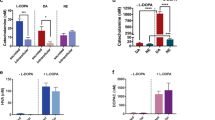Abstract
UNDERSTANDING the actions of the neurotransmitter dopamine in the brain is important in view of its roles in neuropsychiatric illnesses1. Dopamine D1 receptors, which stimulate both adenylyl cyclase2 and phospholipase C3, and D2 receptors, which inhibit them4,5, can nevertheless act synergistically to produce many electrophysiological and behavioural responses6. Because this functional synergism can occur at the level of single neurons, another, as yet unidentified, signalling pathway activated by dopamine has been hypothesized7. We report here that in Chinese hamster ovary (CHO) cells transfected with the D2 receptor complementary DNA, D2 agonists potently enhance arachidonic acid release, provided that such release has been initiated by stimulating constitutive purinergic receptors or by increasing intracellular Ca2+. In CHO cells expressing D1 receptors, D1 agonists exert no such effect. When D1 and D2 receptors are coexpressed, however, activation of both subtypes results in a marked synergistic potentiation of arachidonic acid release. The numerous actions of arachidonic acid and its metabolites in neuronal signal transduction8 suggest that facilitation of its release may be implicated in dopaminergic responses, such as feedback inhibition mediated by D2 autoreceptors, and may constitute a molecular basis for D1/D2 receptor synergism.
This is a preview of subscription content, access via your institution
Access options
Subscribe to this journal
Receive 51 print issues and online access
$199.00 per year
only $3.90 per issue
Buy this article
- Purchase on Springer Link
- Instant access to full article PDF
Prices may be subject to local taxes which are calculated during checkout
Similar content being viewed by others
References
Carlsson, A. Neuropsychopharmacology 1, 179–186 (1988).
Kebabian, J. W., Petzold, G. L. & Greengard, P. Proc. natn. Acad. Sci. U.S.A. 69, 2145–2149 (1972).
Mahan, L. C., Burch, R. M., Monsma, F. J. & Sibley, D. R. Proc. natn. Acad. Sci. U.S.A. 87, 2196–2200 (1990).
De Camilli, P., Macconi, D. & Spada, A. Nature 278, 252–254 (1979).
Vallar, L. & Meldolesi, J. Trends Pharmacol. Sci., 10, 74–77 (1989).
Clark, D. & White, F. J. Synapse 1, 347–388 (1987).
Bertorello, A. M., Hopfield, J. E., Aperia, A. & Greengard, P. Nature 347, 386–388 (1990).
Shimizu, T. & Wolfe, L. S. J. Neurochem. 55, 1–15 (1990).
Gupta, S. K., Diez, E., Heasley, L. E., Osawa, S. & Johnson, G. Science 249, 662–666 (1990).
Berridge, M. J. & Irvine, R. F. Nature 341, 197–205 (1989).
Exton, J. H. J. biol. Chem. 265, 1–4 (1990).
Giros, B., Martres, M. P., Sokoloff, P. & Schwartz, J. C. C.r. hebd. Séanc. Acad. Sci., Paris 311, 501–508 (1990).
Sokoloff, P., Giros, B., Martres, M. P., Bouthenet, M. L. & Schwartz, J. C. Nature 347, 146–151 (1990).
Burch, R. M. Molec. Neurobiol. 3, 156–171 (1989).
Gerfen, C. R. et al. Science 250, 1429–1432 (1990).
Stoof, J. C. & Kebabian, J. W. Nature 294, 366–368 (1981).
Fitzpatrick, F. A. & Murphy, R. C. Pharmac. Rev. 40, 229–241 (1989).
Dumuis, A., Sebben, M., Haynes, L., Pin, J. P. & Bockaert, J. Nature 336, 68–70 (1988).
Starke, K., Göthert, M. & Kilbinger, H. Physiol. Rev. 69, 864–989 (1989).
Piomelli, D. et al. Nature 328, 38–43 (1987).
Schweitzer, P., Madamba, S. & Siggins, G. R. Nature 346, 464–467 (1990).
Bley, K. R. & Tsien, R. W. Neuron 2, 379–391 (1990).
Freeman, E. J., Damron, D. S., Terrian, D. M. & Dorman, R. V. J. Neurochem. 56, 1079–1082 (1991).
Piomelli, D. et al. Proc. natn. Acad. Sci. U.S.A. 86, 8550–8554 (1989).
Giros, B. et al. Nature 342, 923–926 (1989).
Sidhu, A., Van Oene, J. C., Dandridge, P., Kaiser, C. & Kebabian, J. W. Eur. J. Pharmac. 128, 213–220 (1986).
Dal Toso, et al. EMBO J. 8, 4025–4034 (1989).
Salmon, J. A. & Flower, R. J. Meth. Enzym. 86, 477–511 (1982).
Kanterman, R. Y. et al. Molec. Pharmac. 39, 364–369 (1991).
Author information
Authors and Affiliations
Rights and permissions
About this article
Cite this article
Piomelli, D., Pilon, C., Giros, B. et al. Dopamine activation of the arachidonic acid cascade as a basis for D1D2 receptor synergism. Nature 353, 164–167 (1991). https://doi.org/10.1038/353164a0
Received:
Accepted:
Issue Date:
DOI: https://doi.org/10.1038/353164a0
This article is cited by
-
Cocaine-mediated circadian reprogramming in the striatum through dopamine D2R and PPARγ activation
Nature Communications (2020)
-
Potential drug targets and treatment of schizophrenia
Inflammopharmacology (2017)
-
The endocannabinoid system in guarding against fear, anxiety and stress
Nature Reviews Neuroscience (2015)
-
Uncoupling the Dopamine D1–D2 Receptor Complex: A Novel Target for Antidepressant Treatment
Clinical Pharmacology & Therapeutics (2012)
-
The dopamine D4 receptor: biochemical and signalling properties
Cellular and Molecular Life Sciences (2010)
Comments
By submitting a comment you agree to abide by our Terms and Community Guidelines. If you find something abusive or that does not comply with our terms or guidelines please flag it as inappropriate.



